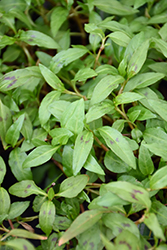Height: 24 inches
Spacing: 12 inches
Sunlight:
![]()
![]()
Hardiness Zone: 8b
Other Names: Vietnamese Mint, Vietnamese Cilantro, Rau Ram
Description:
A visually appealing and delicious culinary herb; perfect addition to gardens and patio containers; features green pointy foliage with interesting burgundy streaks; lemony flavor with a pepper punch, commonly used for salads, soups and stews
Edible Qualities
Vietnamese Coriander is a perennial herb that is commonly grown for its edible qualities. The fragrant pointy green leaves with prominent burgundy stripes are usually harvested from late spring to early fall. The leaves have a pleasant taste.
The leaves are most often used in the following ways:
- Fresh Eating
- Eating When Cooked/Prepared
- Cooking
- Drying
Features & Attributes
Vietnamese Coriander's attractive fragrant pointy leaves remain green in colour with prominent burgundy stripes throughout the season on a plant with a mounded habit of growth. It has masses of beautiful white star-shaped flowers rising above the foliage from late spring to early fall, which are most effective when planted in groupings.
This is an herbaceous perennial herb with a mounded form. Its medium texture blends into the garden, but can always be balanced by a couple of finer or coarser plants for an effective composition. This plant will require occasional maintenance and upkeep, and is best cleaned up in early spring before it resumes active growth for the season. It has no significant negative characteristics.
Aside from its primary use as an edible, Vietnamese Coriander is sutiable for the following landscape applications;
- Mass Planting
- General Garden Use
- Herb Gardens
- Container Planting
- Hanging Baskets
Planting & Growing
Vietnamese Coriander will grow to be about 24 inches tall at maturity, with a spread of 18 inches. When grown in masses or used as a bedding plant, individual plants should be spaced approximately 12 inches apart. Its foliage tends to remain dense right to the ground, not requiring facer plants in front. It grows at a fast rate, and under ideal conditions can be expected to live for approximately 5 years. As an herbaceous perennial, this plant will usually die back to the crown each winter, and will regrow from the base each spring. Be careful not to disturb the crown in late winter when it may not be readily seen!
This plant is typically grown in a designated herb garden. It does best in full sun to partial shade. It prefers to grow in average to moist conditions, and shouldn't be allowed to dry out. It is not particular as to soil type or pH. It is highly tolerant of urban pollution and will even thrive in inner city environments. This species is not originally from North America.
Vietnamese Coriander is a good choice for the edible garden, but it is also well-suited for use in outdoor containers and hanging baskets. It can be used either as 'filler' or as a 'thriller' in the 'spiller-thriller-filler' container combination, depending on the height and form of the other plants used in the container planting. It is even sizeable enough that it can be grown alone in a suitable container. Note that when growing plants in outdoor containers and baskets, they may require more frequent waterings than they would in the yard or garden.
Disclaimer - This resource is provided for informational purposes only and does NOT reflect current availability. Inventory varies seasonally, so we cannot guarantee that every plant will be in stock at all times - please contact your favourite GardenWorks location directly for current availability. It does not include our entire inventory of plants, so be sure to visit GardenWorks to see varieties that may not be represented on this list.

